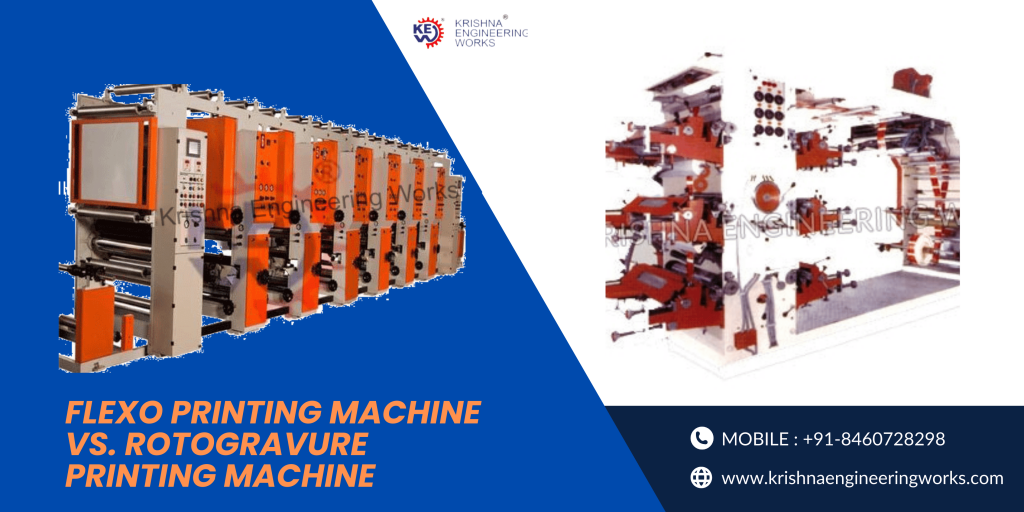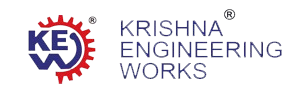
What is Packaging Printing?
The packaging industry has become one of the fastest-growing sectors globally, driven by consumer demand for branded, sustainable, and visually compelling packaging. Whether it’s food pouches, FMCG labels, pharmaceutical packs, or industrial wraps, packaging today is more than protection—it’s communication, shelf appeal, and brand identity.
At the heart of packaging excellence are printing machines, and two dominant technologies have shaped the industry for decades:
- Flexographic Printing Machines (Flexo)
- Rotogravure Printing Machines (Gravure)
Each of these comes with its strengths, limitations, and cost structures. For converters, printers, and brand owners, the choice between a Flexo printing machine and a Gravure printing machine can significantly affect product quality, lead times, profitability, and long-term competitiveness.
At KEW International, we’ve spent over 25 years designing, manufacturing, and exporting both Flexo and Rotogravure Printing Machines, with more than 105 installations in over 30 countries. This gives us a unique perspective on when Flexo works best and when Gravure outperforms, and how businesses can make the right investment decision.
This blog is your comprehensive guide—from working principles to cost analysis, application comparisons, and future trends—to help you decide which printing machine is best for packaging industry.
👉 Which is best for packaging—Flexo or Rotogravure?
Understanding Flexographic Printing Machines
What is Flexographic Printing?
Flexographic printing is a relief printing process where flexible plates made of photopolymer transfer ink directly onto the substrate.
It is mainly known for:
- High-speed printing
- Versatility across substrates
- Cost efficiency for short to medium runs
Explore KEW’s Flexo Printing Machines →
How Flexo Printing Works
- Ink is transferred from an anilox roller to the printing plate.
- The plate, mounted on a cylinder, transfers ink to the substrate.
- Quick-drying inks (water-based, solvent, or UV) allow high-speed continuous printing.
Key Features of Flexo Printing Machines
- Substrate versatility: Paper, films, foils, laminates, corrugated boards.
- Fast setup: Quicker plate changes vs. gravure.
- High speed: Ideal for medium-long runs with tight timelines.
- Ink flexibility: Water, solvent, UV-curable inks.
Advantages of Flexo Printing
✔ Lower plate cost vs. gravure cylinders
✔ Faster setup, less downtime
✔ Versatile for labels, corrugated cartons, pouches
✔ Shorter lead time for new designs
✔ Compatible with eco-friendly inks
Limitations of Flexo Printing
❌ Lower resolution than gravure for ultra-high-quality printing
❌ Plate wear over long runs
❌ Not as cost-effective for extremely long runs (>1 million impressions)
Understanding Rotogravure Printing Machines
What is Rotogravure Printing?
Rotogravure (Gravure) is an intaglio printing process, where images are engraved onto a metal cylinder. Ink fills the engraved cells, and a doctor blade wipes excess ink before transferring the image onto the substrate.
Explore KEW’s Rotogravure Printing Machines →
How Gravure Printing Works
- A copper-plated cylinder is laser or mechanically engraved with cells.
- Ink fills the cells.
- A doctor blade removes excess ink.
- Substrate contacts the cylinder, pulling ink out of the cells.
Key Features of Rotogravure Printing Machines
- Exceptional image quality with photographic detail.
- Durability: Cylinders last millions of impressions.
- High-speed continuous operation for very large runs.
- Multi-color capabilities: 6–10+ color stations.
Advantages of Rotogravure Printing
✔ Unmatched image quality and consistency
✔ Cost-effective for very large volumes
✔ Handles a wide range of substrates (films, foils, laminates, paper)
✔ Cylinders last long, reducing cost per unit for mass runs
✔ Excellent ink laydown → rich colors, metallic effects
Limitations of Gravure Printing
❌ High cylinder engraving cost
❌ Longer setup times vs. flexo
❌ Less economical for short runs
❌ Higher space and capital requirements
Flexo vs Rotogravure: A Technical Comparison
| Feature | Flexo Printing Machine | Rotogravure Printing Machine |
|---|---|---|
| Print Quality | High, but lower resolution than gravure | Superior, photographic detail |
| Setup Time | Quick (hours) | Longer (days) |
| Plate/Cylinder Cost | Low (flexo plates inexpensive) | High (engraved cylinders costly) |
| Run Length Suitability | Short to medium runs | Long runs (millions of impressions) |
| Speed | Very high (comparable to gravure) | Very high |
| Substrate Compatibility | Paper, films, corrugated | Films, foils, laminates, paper |
| Cost Efficiency | Best for <500,000 impressions | Best for >1,000,000 impressions |
| Sustainability | Water-based inks possible | Solvent inks dominant, but eco-shifts underway |
Packaging Applications: Where Each Excels
- Food Packaging:
- Flexo: Labels, corrugated cartons, short-run pouches
- Gravure: Long-run snack, confectionery, and frozen food packaging
- Pharma & Medical:
- Flexo: Blister packs, small batch medicine cartons
- Gravure: High-volume foil packaging
- FMCG & Retail:
- Flexo: Promotional packaging, seasonal designs
- Gravure: Large-scale detergent, personal care packs
- Industrial & Specialty:
- Flexo: Flexible packaging with frequent design changes
- Gravure: Premium finishes, metallic inks
Cost & ROI Analysis (Qualitative)
Flexo Printing Machine ROI
- Lower upfront investment
- Quicker design-to-market turnaround
- Economical for short/medium runs
- Lower consumable cost (plates, inks)
Rotogravure Printing Machine ROI
- High initial investment (cylinders, engraving)
- Very low per-unit cost at scale
- Long-term savings for continuous production
- Higher resale value for printed products with premium quality
Market Trends Shaping Flexo vs Gravure
- Short-run packaging demand → Boosting Flexo adoption
- Premium FMCG packaging → Gravure remains dominant
- Sustainability focus → Water-based flexo inks gaining traction
- Digital hybridization → Flexo machines integrating digital modules
- Emerging markets (India, Brazil, Africa) → Gravure still strong due to volume economics
Now the big question that comes to your mind is which technology fits your business best—Flexo or Gravure? We’ll break down the key steps to help you decide, and if you’re still unsure, our engineers are just a click away to guide you personally.
How to Choose: Flexo or Gravure?
Choose Flexo if:
- You handle short to medium print runs
- You need quick turnaround and frequent design changes
- You prioritize lower capex and faster ROI
Choose Gravure if:
- You operate in high-volume packaging markets
- You need superior image quality and consistency
- You can manage higher upfront investment for long-term savings
Now you might be wondering where to get these machines—whether it’s Flexo or Gravure.
At KEW International, we manufacture both Flexo and Rotogravure Printing Machines, ensuring clients can choose the right solution for their packaging needs.
- 105+ installations in 30+ countries
- Award-winning innovation
- Complete after-sales support
- Customized turnkey solutions
FAQs
Q1. What is the price difference between Flexo and Rotogravure printing machines?
- Flexo: Lower capex, cheaper plates, ideal for medium runs.
- Gravure: Higher upfront cost (cylinders), but cost-efficient for mass production.
Q2. Which printing process offers better quality?
- Gravure offers superior photographic quality, but Flexo has improved greatly with modern plate technology.
Q3. Which is more sustainable?
- Flexo: Water-based inks, lower energy use.
- Gravure: Moving toward eco-solvent and water-based inks, but slower adoption.
Q4. Can KEW provide turnkey printing + packaging solutions?
- Yes, from Slitting, Coating, and Laminating Machines to Web Guiding and Rewinding Systems.
The Final Word for Flexo vs Gravure
There is no one-size-fits-all answer.
- If you need speed-to-market, flexibility, and cost efficiency for short runs, Flexo Printing Machines are the clear choice.
- If you need unparalleled image quality and mass-production economics, Rotogravure Printing Machines dominate.
At KEW International, our engineers are here to help you choose, install, and maintain the right technology—so your packaging stands out in a competitive world.
📞 Contact KEW International Today
- Get a customized consultation for your packaging business.
- Explore ROI-driven machine recommendations.
- Access global after-sales service & training.
Author: Chief Engineer, Krishna Engineering Works (KEW International)
Global leader in printing and converting machinery with 25+ years of engineering excellence.
